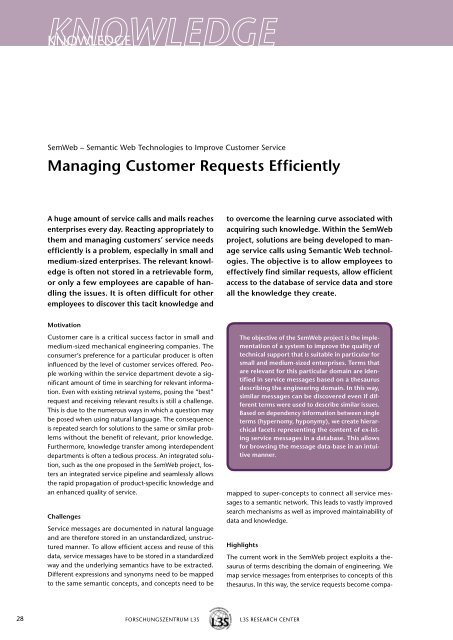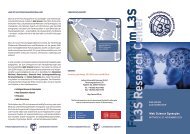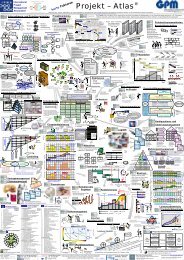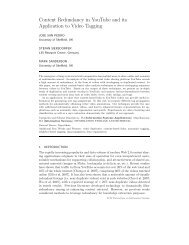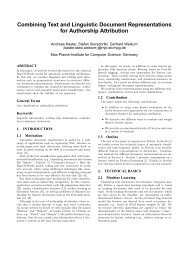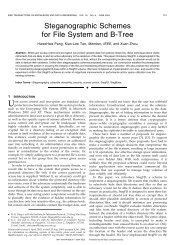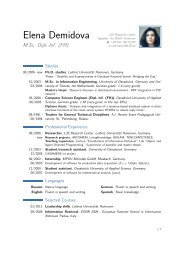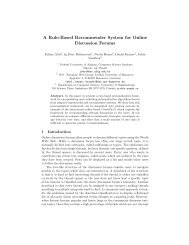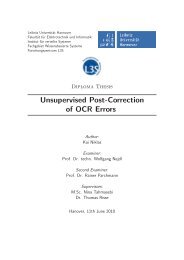knowledge · information · learning - Forschungszentrum L3S
knowledge · information · learning - Forschungszentrum L3S
knowledge · information · learning - Forschungszentrum L3S
You also want an ePaper? Increase the reach of your titles
YUMPU automatically turns print PDFs into web optimized ePapers that Google loves.
28<br />
KNOWLEDGE<br />
SemWeb – Semantic Web Technologies to Improve Customer Service<br />
Managing Customer Requests Efficiently<br />
A huge amount of service calls and mails reaches<br />
enterprises every day. Reacting appropriately to<br />
them and managing customers’ service needs<br />
efficiently is a problem, especially in small and<br />
medium-sized enterprises. The relevant <strong>knowledge</strong><br />
is often not stored in a retrievable form,<br />
or only a few employees are capable of handling<br />
the issues. It is often difficult for other<br />
employees to discover this tacit <strong>knowledge</strong> and<br />
Motivation<br />
Customer care is a critical success factor in small and<br />
medium-sized mechanical engineering companies. The<br />
consumer’s preference for a particular producer is often<br />
influenced by the level of customer services offered. People<br />
working within the service department devote a significant<br />
amount of time in searching for relevant <strong>information</strong>.<br />
Even with existing retrieval systems, posing the “best”<br />
request and receiving relevant results is still a challenge.<br />
This is due to the numerous ways in which a question may<br />
be posed when using natural language. The consequence<br />
is repeated search for solutions to the same or similar problems<br />
without the benefit of relevant, prior <strong>knowledge</strong>.<br />
Furthermore, <strong>knowledge</strong> transfer among interdependent<br />
departments is often a tedious process. An integrated solution,<br />
such as the one proposed in the SemWeb project, fosters<br />
an integrated service pipeline and seamlessly allows<br />
the rapid propagation of product-specific <strong>knowledge</strong> and<br />
an enhanced quality of service.<br />
Challenges<br />
Service messages are documented in natural language<br />
and are therefore stored in an unstandardized, unstructured<br />
manner. To allow efficient access and reuse of this<br />
data, service messages have to be stored in a standardized<br />
way and the underlying semantics have to be extracted.<br />
Different expressions and synonyms need to be mapped<br />
to the same semantic concepts, and concepts need to be<br />
FORSCHUNGSZENTRUM <strong>L3S</strong> <strong>L3S</strong> RESEARCH CENTER<br />
to overcome the <strong>learning</strong> curve associated with<br />
acquiring such <strong>knowledge</strong>. Within the SemWeb<br />
project, solutions are being developed to manage<br />
service calls using Semantic Web technologies.<br />
The objective is to allow employees to<br />
effectively find similar requests, allow efficient<br />
access to the database of service data and store<br />
all the <strong>knowledge</strong> they create.<br />
The objective of the SemWeb project is the implementation<br />
of a system to improve the quality of<br />
technical support that is suitable in particular for<br />
small and medium-sized enterprises. Terms that<br />
are relevant for this particular domain are identified<br />
in service messages based on a thesaurus<br />
describing the engineering domain. In this way,<br />
similar messages can be discovered even if different<br />
terms were used to describe similar issues.<br />
Based on dependency <strong>information</strong> between single<br />
terms (hypernomy, hyponymy), we create hierarchical<br />
facets representing the content of ex-isting<br />
service messages in a database. This allows<br />
for browsing the message data-base in an intuitive<br />
manner.<br />
mapped to super-concepts to connect all service messages<br />
to a semantic network. This leads to vastly improved<br />
search mechanisms as well as improved maintainability of<br />
data and <strong>knowledge</strong>.<br />
Highlights<br />
The current work in the SemWeb project exploits a thesaurus<br />
of terms describing the domain of engineering. We<br />
map service messages from enterprises to concepts of this<br />
thesaurus. In this way, the service requests become compa-


